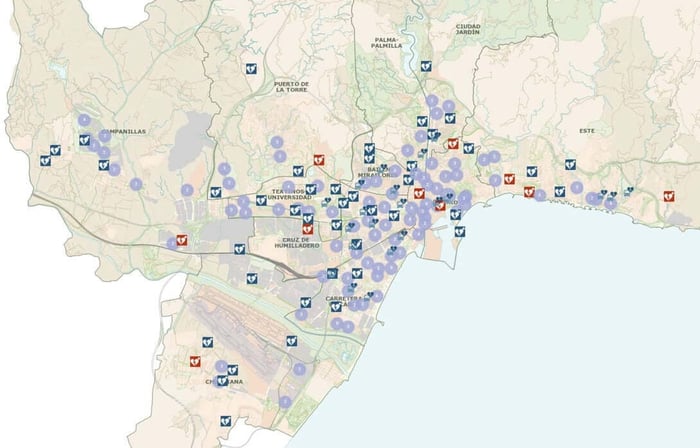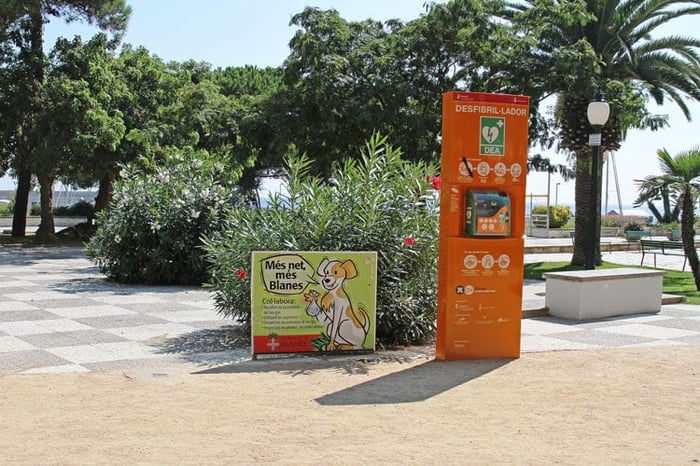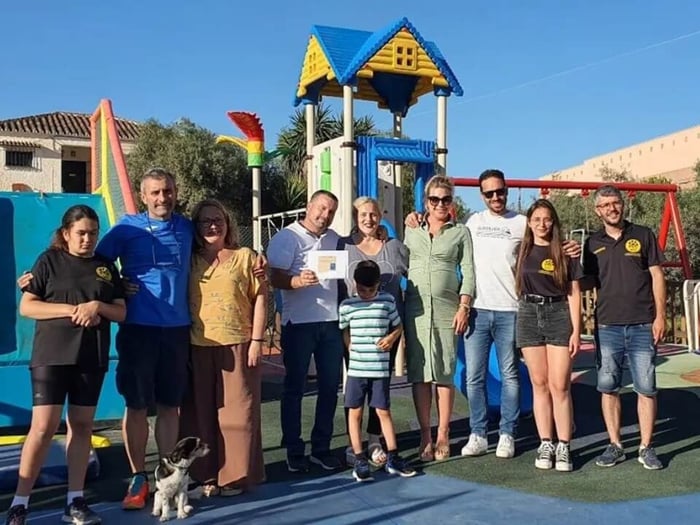Defibrillators on the Costa del Sol
18th March, 2023
In the interest of public health, it is crucial to increase the number of defibrillators in public spaces and make people aware of where to find them. Heart disease continues to be one of the leading causes of death worldwide. It accounts for around 50,000 cardiac arrests annually throughout Spain. With more than six hundred defibrillators in Malaga City alone, raising public awareness of where to find one on the Costa del Sol is essential, especially when you consider that Malaga has produced a map of where to find one in the city.
Click here to locate defibrillators in Malaga.
Using a defibrillator before an ambulance arrives can make it much more likely that someone will be saved. But, in a medical emergency, would you know where to look for a defibrillator and what to do? Here at Mediterranean Homes, we have outlined how to locate a defibrillator and what to do during a cardiac arrest.

Where can I find a Defibrillator on the Costa del Sol?
Defibrillators should be available in the following locations throughout Andalucia:
- Large retail spaces of more than 2,500 square meters
- Airports
- Ports
- Bus or railway stations and stops in towns with a population of more than 50,000 people
- Metro stations with an average daily influx of 5,000 or more people
- Sports facilities, centres, or complexes with five hundred or more daily visitors
- Public establishments with a capacity of 5,000 or more people
Defibrillators can also be found in police vehicles, pharmacies, and sports centres, with fewer than five hundred visitors per day in many towns along the Costa del Sol.
What exactly is a defibrillator?
Defibrillators are devices that can save lives! They are powered by electricity and help many people who have had a heart attack stay alive. More than 30.000 people die in Spain each year due to cardiac arrest. Early, immediate care is critical to increasing the chance of survival from these events. Every member of the public should be able to recognise a defibrillator and feel confident in using it where necessary, especially when there is no medical professional nearby.

What do defibrilators do, and how do they work?
It is a machine that gives the heart an electric charge and lets it return to work. It has sensors that analyse the heart's rhythm and show when and how much energy should be applied when applying a charge.
This device can help the heart return to a normal rhythm by delivering energy through the chest wall. The amount of time available to treat a patient and reverse the situation if they have a heart attack is condensed. Defibrillators are crucial for preserving lives because of this. The defibrillator figures out how long and how much electricity to send to the heart at the right time.
What is the procedure for using a defibrillator?
Using one of these devices is easy, but everyone should have prior training to help save lives.
EFR provides first aid training and AED installation throughout Andalucia, including Granada, Seville, Malaga, Cordoba, Jaen, Cadiz, and Huelva, and can be reached here.
However, these are the basic steps if you ever find yourself in a position where you need to use a defibrillator:
- Switch it on.
- Place the electrodes on the right collarbone, the left side of the chest, and beneath the armpit.
- Based on myocardial activity, the device will decide whether to deliver a charge.
The patient must not be touched during this time because it may interfere with the process.
Am I Permitted To Use Defibrillators In Case Of Emergency?
There is no answer to the question of who can use a defibrillator because each autonomous community has its own set of laws.
Sometimes, only those who have received authorized training can use the device. In other situations, though, heart protection and the need for a quick response in cardiac arrest are more important. In both Asturias and Andalusia, defibrilators can only be used by people who have been trained in CPR or by health professionals.
If an intervention is to be taken outside of a medical facility, you must contact the medical emergency service by calling 112.
In Catalonia, the Basque Country, Madrid, Valencia, and the Canary Islands, the law is more lenient, stating that if no one with medical or CPR knowledge is present, anyone can use the defibrillator as long as they have dialed 112 for assistance beforehand.
In such cases, the range of activities in the survival chain expands, providing more opportunities to treat people with heart problems. Remember that public-access defibrillators instruct the user on what to do.
Some defibrillators are permanently linked to 112, so emergency services can tell you how to help save a life. There are some defibrillation devices that also ask whether the patient is a child or an adult. It’s estimated that there are three defibrillators for every 10,000 people in Spain. This rate is meager (5 times that of the United Kingdom, for example). Spain lags behind the rest of the European Union in installing these devices.
The leading countries for installing defribilators are Japan, with 25 per 10,000 inhabitants, and France with nearly 20 per 10,000 inhabitants.
Aside from the few defibrillation devices installed, there is little information on their locations. When it comes to installing defibrillators, which use electricity to save many lives in minutes, Spain has a long way to go. When people have heart problems, the time it takes to find this type of treatment is critical for survival. "In comparison to other European countries, Spain has far fewer defibrillators per inhabitant." A Review and comparison of Spain's current laws regarding the use of external defibrillators outside of medical facilities among the country's autonomous communities can be read here.

Actions to take in an emergency
The first thing to do whenever someone is unconscious and not breathing is to call the emergency service hotline.
The emergency number to call in Spain is 112.
112 is the equivalent to dialling 999 in the UK.
Alternatively, dial 061 to reach the ambulance service directly.
The next step is to ask a helper to find a member of the public from the area because they will likely know whether or not there is a defibrillator nearby.

Begin CPR on the person until the defibrillator or an ambulance arrives.
Do hands-only CPR (cardiopulmonary resuscitation) until the paramedics arrive, this entails 100 to 120 chest compressions per minute. You must quickly and forcefully push in the middle of the chest to perform chest compressions.
You do not have to breathe for the person.
If no one is around who knows where a defribilator is, ask someone to look around to see if an AED (automated external defibrillator) is available. Even an AED for use in the house is available for purchase. Using an AED doesn't require any special training because it will instruct you on how to use it.
Remember! The AED device will only shock when it is necessary.
Defibrillator Locations on the Costa del Sol
Facebook Group - Anyone is Welcome to Join!
Defibrillator Locations on the Costa del Sol is a group sponsored by Mediterranean Homes to raise awareness of where to locate defibrillators in the towns and villages throughout the Costa del Sol, how to access them, and how easy it is to use one.
Here's what you can do to help...
Please post photos with the exact locations of an AED (automated external defibrillator) in your area here and state clearly the name of the town or village where it can be found. Then invite as many people as possible in the surrounding areas that you know to this group.
Any advice from trained paramedics is welcome, along with details of training sessions on CPR and defibrillator use locally.
Please add friends, colleagues, and relatives to the group.
LET'S SAVE LIVES TOGETHER






